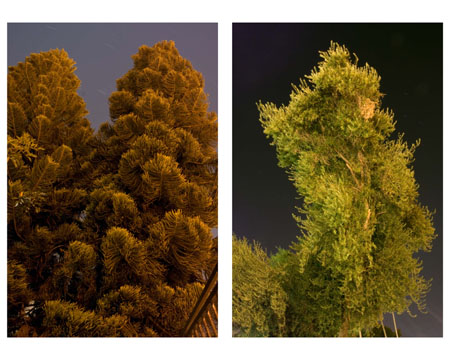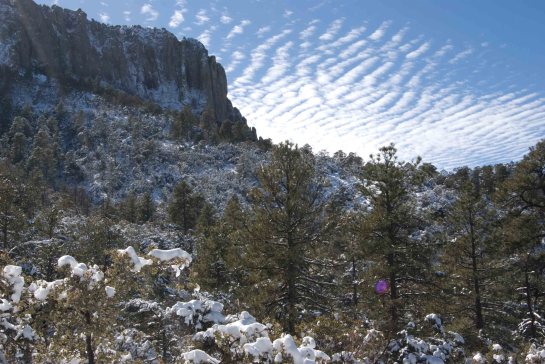

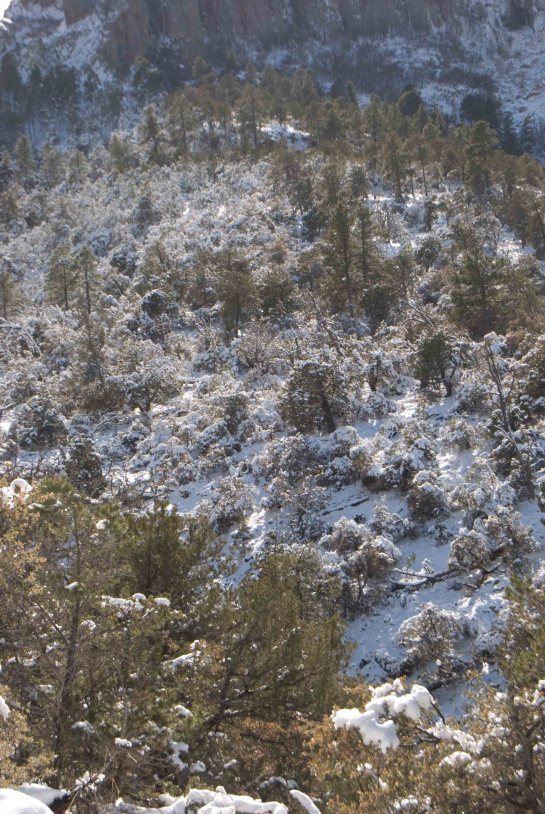
More Into the Green:
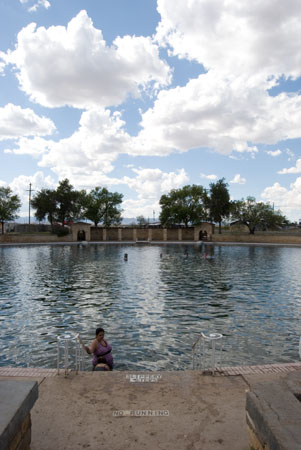
Whether they are classified as arroyos, oases, wadis, tinajas, cienegas, step-wells or swimming holes, collections of fresh water in arid lands — however fleeting they may be — possess an air of holiness, the abundance of life-giving liquid radiating with metaphysical fertility when surrounded by miles of dry earth. Among such human-made temples of Dihydrogen monoxide, the San Solomon Springs of Balmorhea, Texas, stands as one of the most opulent — though little-known outside of Texas — in all of the American Southwest [1]
Balmorhea is a small town on the great high-desert grasslands of Far West Texas, an outpost of some 527 people that sits just a few miles south of Interstate 10 between Ft. Stockton and Van Horn. The abundant springs were discovered by enterprising Anglos in the early part of the 20th century; the founding of the town Balmorhea quickly followed in 1906. While the exotic nature of the town’s name — pronounced Bal-mor-ay — suggests the stuff of Native American ghost stories (or Western-Gothic instrumental music), its origin is far more mundane. As the story goes, the three land developers responsible for luring settlers to this remote desert oasis could not decide upon a name for their holdings and, as the great-grandson of E.D. Balcome tells Texas Escapes:
According to my father, the name of the town was suggested during a dispute between my great-grandfather, Mr. Morrow and the Rhea brothers by the conductor of the train they were riding on. What little I know of my ancestor and those that joined with him in the venture is indicative that certainly none of them possessed such creativity.
These developers were hardly the first to have discovered these artesian springs, of course. They were previously known as Mescalero Springs, for the Jumano and Mescalero Indians that made use of the water for various agricultural projects. Following that Mexican farmers gave them the name San Solomon Springs. [2]
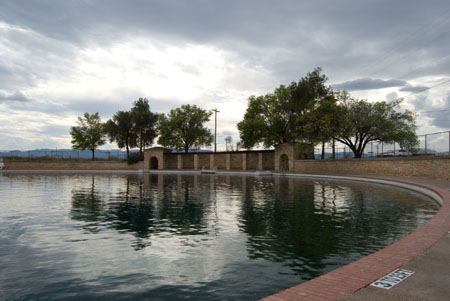
The 22-28 million gallons of water that this artesian spring produces on a daily basis collects into a massive 77,053 square foot pool [3]; two long rectangular sections extend from the main circular swimming pond. One of the extensions features a concrete bottom and is shallow enough for children. The rest of the pool ranges from five to 25-feet deep, and the water is clear down to the bottom. A pair of goggles reveals Mexican tetras, lone Channel catfish, the occasional crawdad and Comanche Springs Pupfish and Pecos Gambusia, both endangered. The surface is broken by large Texas Spiny Softshell Turtles coming up for air, and by the bubbles discharged by scuba divers [4] exploring the clumps of Chara algae that wave lazily down in the rocky depths [5]. The water temperature ranges from 72-76 degrees Fahrenheit, year round.
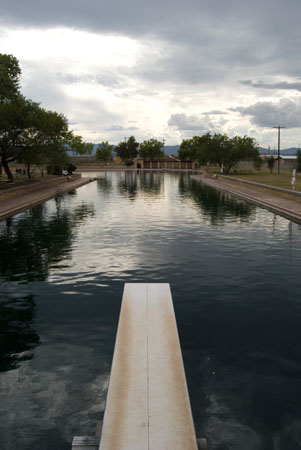
The pool is surrounded by Spanish-style adobe and stone architecture constructed by the Civilian Conservation Corps in the late ’30s and early ’40s. The ideology behind the CCC projects fosters a populist utopia here on weekends: Stone shelters and adobe dining halls are full of families celebrating birthdays and reunions, children running over the grass while their parents throw footballs and keep watch on the grills. The water is full of waders staying cool, wandering in the shallows, or splashing about on fluorescent foam water noodles. People stand in a short line to do jackknifes and cannonballs off the high dive. Others roast their backs in the West Texas sun, tracking schools of fish and exhaling through snorkels.

Weekdays are a different matter: The pool is deserted, and once one becomes accustomed to the nibbling teeth of the Mexican tetras, it’s possible to float quietly for hours, drifting aimlessly amidst the reflected clouds hanging in the sky up above.
NOTES:
[1] Technically speaking, the San Solomon Springs are part of Balmorhea State Park, which is located in the neighboring town of Toyahvale, TX. Though with a shrinking population — 60 people at the 2000 census — travelers are advised to follow road signs to Balmorhea when seeking these waters.
[2] “San Solomon Springs,” The Handbook of Texas
[3] Balmorhea State Park, Texas Parks and Wildlife
[4] “San Solomon Springs,” Dive Training Magazine
[5] “San Solomon Springs, Balmorhea, TX” from The Encyclopedia Earth
More Into the Green … Read More
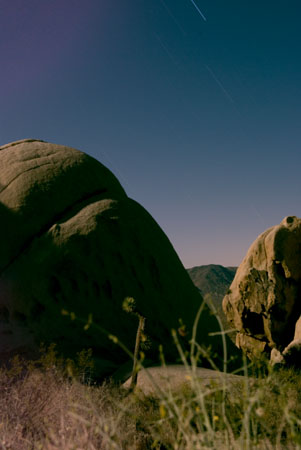 23:49:29 – 00:04:48
23:49:29 – 00:04:48
Full moon exposures from the night of 9-10 May 2009. Documented at a backcountry campsite on the northwestern slope of the Hexie Mountains, near the Squaw Tank monzogranite in Joshua Tree National Park.
 01:11:09 – 01:23:55
01:11:09 – 01:23:55
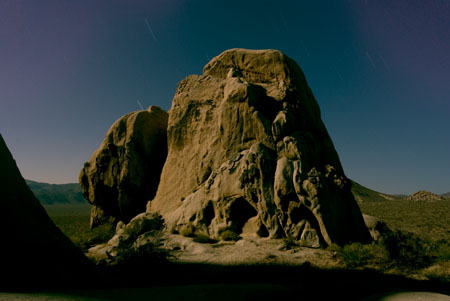 01:30:39 – 01:45:02
01:30:39 – 01:45:02
 01:54:15 – 02:09:05
01:54:15 – 02:09:05

Kahili Ginger (Hedychium gardnerianum) is a fragrant flowering plant native to eastern India. It is also ranked in the Global Invasive Species Database as one of the 100 most destructive invasive species on Earth. Its manner of propagation depends in large part on Homo sapiens‘ marked affinity for its deeply alluring scent and vibrant colors — its introduction to the Hawaiian Islands is blamed on the ornamental horticulture industry. Upon entering the glade in which these plants had taken up shop, we became so intoxicated by their sensuous odor that we mistook this most vicious of invaders as being endemic to the island of Kaua’i.
Kahili Ginger is a mortal threat to many endemic species and can choke entire forests — blocking out the life-giving rays out of the sun, slowly suffocating whatever seedlings that have the misfortune of being rooted beneath its slick, wide leaves. It is a particular menace to the native rain forests of the Hawaiian Islands. But still so easy on the eyes and nose.

This salmon-colored starburst of Lovecraftian horror is Aseroë rubra, a name that translates from Greek to English as something like “red fungus with disgusting juice.” The rotted-meat-scented juice of this Australia-native fungus — also known as a sea anemone stinkhorn — is brown in the specimen pictured above; this seems apt given that it is smeared around the fleshy, gaping orifice that serves as entry point to its hollow stalk.
The juice — let’s go ahead and clarify that it’s actually a spore-laden gel called gleba — is quite viscous, which prevents it from washing away in the frequent rainstorms that break over the Alaka’i Swamp. Its odor — alternately described in terms of shit and dead flesh — attracts flies and other carrion-feeders, who then spread the spores in their own foul little poops: Witness the gleba-gobbling fly on the 2 o’clock tentacle.
A black and white photo of just such a specimen as the one pictured — discovered in a tattered old trail guide — is what convinced the Into The Green mission to explore the Alaka’i Swamp, a tropical moist forest located just under 4,000 feet in altitude in northwest Kaua’i. The mountain range in the horizon from our earlier set of Kaua’i Photos — click here to read about our first night on the island — separated our Wainiha Valley cottage from these fetid highlands. Part of Kaua’i’s imperviousness when it comes to development is a result of the fact that no road divides the center of the island, nor circumvents its shoreline. Thus a location just some 18 miles from the Wainiha Valley can only be reached via automobile by traversing 75 miles — nearly the entire circumference of the island. The other alternative being an epic days-long trek through the soggy wilderness.
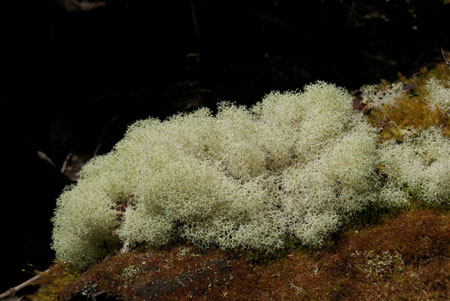
And finally we have this bushy lichen of what we believe to be the Cladina species. It is frothing up from a decaying tree stump, sparkling with the rain that falls approximately every 20-40 minutes in the Alaka’i Swamp.
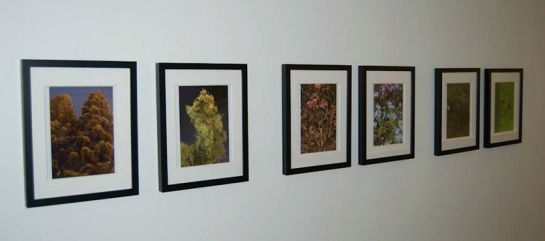
The photographs in this series were on display at Art Center College of Design in Pasadena, CA from December 7-11, 2008.
Urban outdoor lighting produces enough spectral pollution to turn the city’s night sky into an orange-grey dome, smudging out all but the brightest stars. Of the myriad organisms affected by humanity’s colonization of the darkness by way of electromagnetic radiation, plants are of particular interest. Plant life cycles revolve according to their light environment: Photoreceptors tell them when to extend stems or broaden leaves; when to germinate and when to die.
These images are an examination of photosynthetic organisms as painted with the palette of artificial night lighting. The viewer’s attention is drawn away from the horizon — where the natural light has disappeared — to emphasize the industrial lighting on the organic textures. Tree limbs are framed against the night sky, nebulous clouds of leaves reflecting the glare of sodium vapor security lamps; groundcover is shot from directly above, micro-landscapes rendered in the orange halide tones of residential streetlights.
All of these images were made after civil twilight — when the sun is six degrees below the horizon — using available light with exposures from 20 to 696 seconds.
